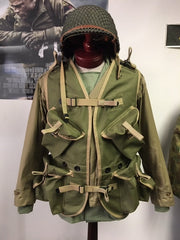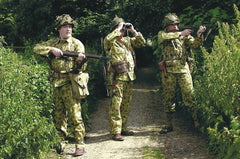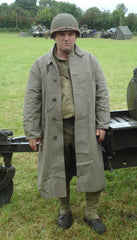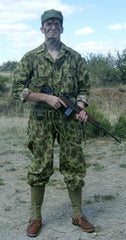U.S. Army Regular Issue Field Uniforms

The US Army's Camouflage By Horizon concept carried right on into the design of field uniform jackets and trousers. As you can see in the photo at right colors of the field uniform (OD Field Jacket) contrasted to the shades of the OD wool uniform, and the color of the steel helmet. The Army standardized many numbered shades of Olive Drab with OD #3 being the earliest shade used in field uniforms. By the end of WWII the army standardized all field uniforms to be dyed in the darker shade of OD #7.
In the years preceding WWII the U.S. military suffered from lack of funding and outdated materiel. The world witnessed the growth of aggression in Europe, North Africa, and in Asia in the late 1930s and early 1940s. Countries like Germany and Japan were modernizing their militaries with state of the art technologies that were close to rendering the United States military outdated. Therefore, the United States government made the hurried decision to mobilize and re-outfit an aging United States military. Once the decision was made to mobilize, the various services dug into their research and development departments to expand effectiveness. In this effort the U.S. Army Quartermaster Corps. was made responsible to uniform new armored, mechanized, parachute, mountain, and special forces troops. Each one of these force types aspired for unique uniform styles to reflect the needs of their assigned missions. As the mobilization progressed between 1940-1942 however, it became clear to the QM Corps that such variations between force type uniforms was unpractical and needed to be streamlined and standardized. When all was said and done, the U.S. Army adopted the OD #7 shaded M1943 field uniform as the standard for ALL units.
Soldiers in the field wore their regulation OD wool and khaki cotton uniforms in lieu of the field uniform items you see listed on this page. These field uniforms items were designed to be used as a shell garment. On the other hand, many Army unit headquarters decided that when troops needed it, a roomy utilitarian work "fatigue" uniform was preferred for comfort and range of movement instead of the regulation shirts and trousers. The Herringbone Twill (HBT) fatigue uniform served this role well. These HBT fatigues were produced in various designs and colors. Some Army units serving the hot and humid climates of the South Pacific campaigns required the wearing of just undergarments and HBT fatigues while other units serving in cooler areas where the risk of gas attack was high dictated the layered wearing of all woolen, field, and HBT uniforms concurrently.
Featured on this page is an index of our complete line of regular issue United States Army field uniforms.



